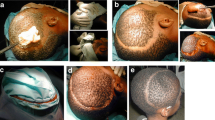Abstract
Technique
We present the use of a zig-zag bicoronal scalp incision for cranial-facial cases in paediatric neurosurgery.
Conclusion
The authors believe that this technique leads to improved cosmesis, especially when the hair is wet.



Similar content being viewed by others
References
Di Rocco C (2003) How to decrease the impact of surgical scar in the correction of sagittal synostosis. Childs Nerv Syst 19:42–45
Kerawala CJ, Grime RJ, Stassen LF et al (2000) The bicoronal flap: an audit of morbidity and a proposed surgical modification in male pattern baldness. Br J Oral Maxillofac Surg 38:441–444
Netscher DT, Stal S, Peterson R (1990) A critical analysis of coronal incisions. Plast Reconstr Surg 86:167–169
Author information
Authors and Affiliations
Corresponding author
Rights and permissions
About this article
Cite this article
Leach, P., Rutherford, S., Likhith, A. et al. Zig-zag bicoronal scalp incision for cranio-facial cases in paediatric neurosurgery. Childs Nerv Syst 20, 483–484 (2004). https://doi.org/10.1007/s00381-004-0992-5
Received:
Published:
Issue Date:
DOI: https://doi.org/10.1007/s00381-004-0992-5




